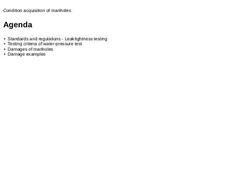
|

|
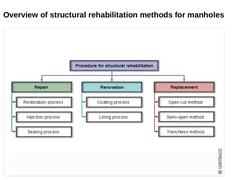
|

| (Image: Overview of the main processing groups for the structural rehabilitation of drain and sewer systems)
|
|
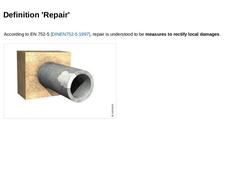
|

|
According to EN 752-5 [DINEN752-5:1997], repair is understood to be measures to rectify local damages. (Image: Repair)
|
|

|

|
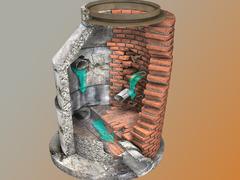
|

Manholes perform a variety of functions, they are used to connect pipelines, to change direction and/or elevation, to provide access for personnel and/or equipment, and for aeration and ventilation of the drain and sewer system. Like sewers and pipes, defective manholes need to be rehabilitated. This module explains the structure, functions, and possible structural conditions of manholes. After completing this module, you will have a sound knowledge of: - functions and requirements of manholes;
- construction methods of manholes;
- sealing materials made of elastomers;
- common structural damages and procedures for structural rehabilitation.
|
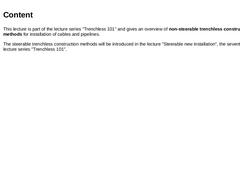
|

This lecture is part of the lecture series "Trenchless 101" and gives an overview of non-steerable trenchless construction methods for installation of cables and pipelines. The steerable trenchless construction methods will be introduced in the lecture "Steerable new installation", the seventh part of the lecture series "Trenchless 101". |
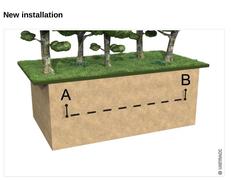
|

| (Image: New installation)
|
|
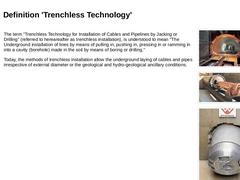
|

|
The term "Trenchless Technology for Installation of Cables and Pipelines by Jacking or Drilling" (referred to hereareafter as trenchless installation), is understood to mean "The Underground installation of lines by means of pulling in, pushing in, pressing in or ramming in into a cavity (borehole) made in the soil by means of boring or drilling." Today, the methods of trenchless installation allow the underground laying of cables and pipes irrespective … |
|
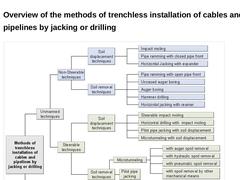
|

| (Image: Overview of the methods of trenchless installation of cables and pipelines by jacking or drilling)
|
|
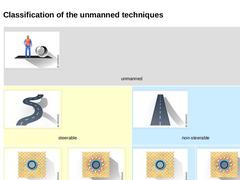
|

| (Image: Unmanned techniques)
unmanned | | (Image: Steerable techniques)
steerable | (Image: Non-steerable techniques)
non-steerable | | (Image: Soil removal techniques)
soil removal | (Image: Soil displacement techniques)
soil displacement | (Image: Soil removal techniques)
soil removal | (Image: Soil displacement techniques)
soil displacement |
|
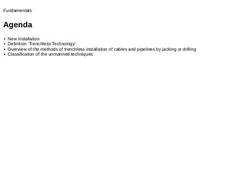
|

|
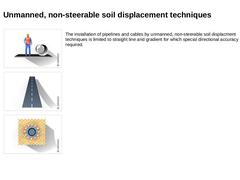
|

|
(Image: Unmanned techniques)
|
|
(Image: Non-steerable techniques)
|
|
(Image: Soil displacement techniques)
|
|
The installation of pipelines and cables by unmanned, non-steerable soil displacment techniques is limited to straight line and gradient for which special directional accuracy is not
required. |
|

|

|
(Image: Soil displacement technique - impact moling)
|
|
(Image: Soil displacement technique - pipe ramming with closed pipe front)
|
|
Included in the unmanned, non-steerable displacement techniques are: - Impact Moling
- Pipe ramming with closed pipe front
- Horizontal jacking with expander .
| |
(Image: Soil displacement technique - horizontal jacking with expander (1st phase))
|
(Image: Soil displacement technique - horizontal jacking with expander (2nd … |
|
|
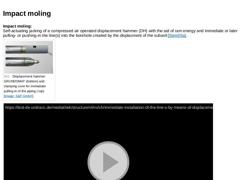
|

Impact moling:
Self-actuating jacking of a compressed air operated displacement hammer (DH) with the aid of ram energy and immediate or later pulling- or pushing-in the line(s) into the borehole created by the displacment of the subsoil (not found). (Image: Displacement hammer GRUNDOMAT (bottom) and clamping cone for immediate pulling-in of the piping ( top)) (Video: Immediate installation of the line(s) by means of displacement hammer (GRUNDOMAT))… |
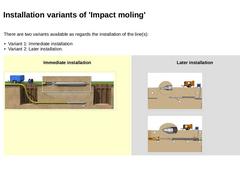
|

|
There are two variants available as regards the installation of the line(s): - Variant 1: Immediate installation
- Variant 2: Later installation.
| Immediate installation (Image: Immediate installation of the line by means of impact moling)
| Later installation |
(Image: Installation of a pipe with DH (variant 2.2) according to [FI-Tracta] [Stein89g] [Image: S&P GmbH] - Phase 1: Pilot boring)
|
|
(Image: Installation of a pipe with DH (variant 2.2) according … |
|
|
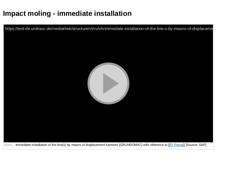
|

(Video: Immediate installation of the line(s) by means of displacement hammer (GRUNDOMAT)) |
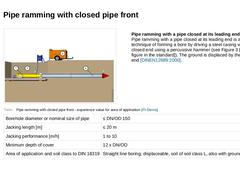
|

| (Image: Soil displacement technique - pipe ramming with closed pipe front)
|
Pipe ramming with a pipe closed at its leading end:
Pipe ramming with a pipe closed at its leading end is a technique of forming a bore by driving a steel casing with a closed end using a percussive hammer (see Figure 3 [see figure in the standard]). The ground is displaced by the closed end [DINEN12889:2000]. | (Table: Pipe ramming with closed pipe front - experience value … |
|
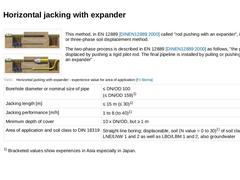
|

|
(Image: Horizontal jacking with expander - phase 1: Jacking the pilot drill)
|
|
(Image: Horizontal jacking with expander - phase 2: Pulling back the pilot drill rod string with expander and connected piping)
|
|
This method, in EN 12889 [DINEN12889:2000] called "rod pushing with an expander", is a two- or three-phase soil displacement method. The two-phase process is described in EN 12889 [DINEN12889:2000] as follows, "the ground is displaced by pushing … |
|
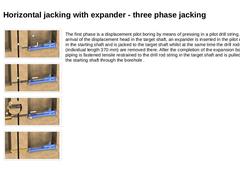
|

|
(Image: Method of operation and sequence for the SPEEDER SR-12 with reference to [FI-Hosho] [Image: S&P GmbH] - Pilot bore)
|
|
(Image: Method of operation and sequence for the SPEEDER SR-12 with reference to [FI-Hosho] [Image: S&P GmbH] - Expansion bore)
|
|
(Image: Method of operation and sequence for the SPEEDER SR-12 with reference to [FI-Hosho] [Image: S&P GmbH] - Pulling in the line)
|
|
(Image: Method of operation and sequence for the SPEEDER SR-… |
|
|
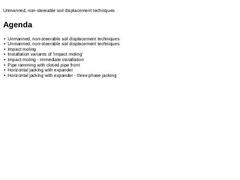
|

|
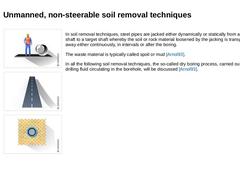
|

|
(Image: Unmanned techniques)
|
|
(Image: Non-steerable techniques)
|
|
(Image: Soil removal techniques)
|
|
In soil removal techniques, steel pipes are jacked either dynamically or statically from a starting shaft to a target shaft whereby the soil or rock material loosened by the jacking is transported away either continuously, in intervals or after the boring. The waste material is typically called spoil or mud [Arnol93]. In all the following soil removal … |
|
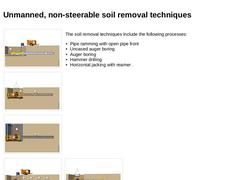
|

|
(Image: Soil removal technique - pipe ramming with open pipe front)
|
|
(Image: Soil removal technique - uncased boring (free boring))
|
|
(Image: Soil removal technique - auger boring)
|
|
The soil removal techniques include the following processes: - Pipe ramming with open pipe front
- Uncased auger boring
- Auger boring
- Hammer drilling
- Horizontal jacking with reamer .
| |
(Image: Soil removal technique - hammer drilling)
|
(Image: Soil removal techique - … |
|
|
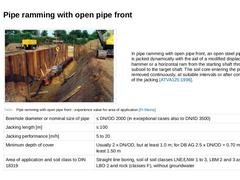
|

| (Image: Pipe ramming with open pipe front - site situation [FI-Steina])
|
In pipe ramming with open pipe front, an open steel pipe string is jacked dynamically with the aid of a modified displacement hammer or a horizontal ram from the starting shaft through the subsoil to the target shaft. The soil core entering the pipe is removed continuously, at suitable intervals or after completion of the jacking [ATVA125:1996]. | (Table: Pipe ramming with open … |
|
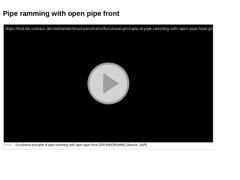
|

(Video: Functional principle of pipe ramming with open pipe front (GRUNDORAMM)) |
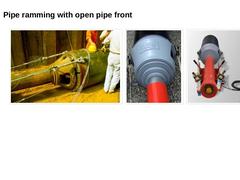
|

|
(Image: Horizontal ram with soil removal adaptor and impact segment installed in the starting shaft)
|
(Image: Horizontal ram with soil removal adaptor and impact cone)
|
(Image: Horizontal ram with soil removal adaptor, impact cone and carriage)
|
|
|